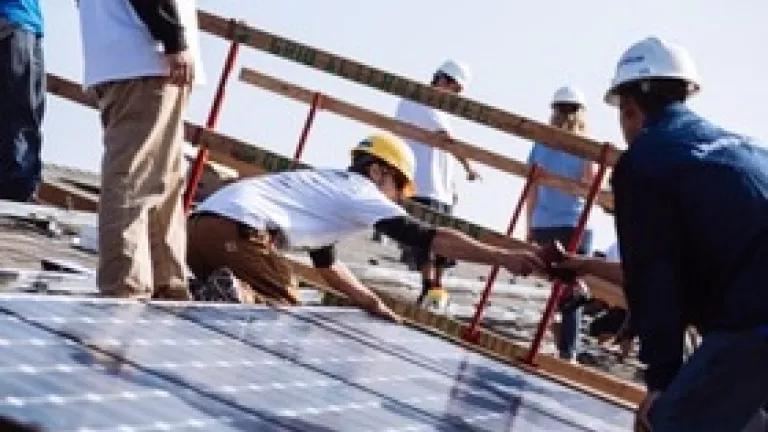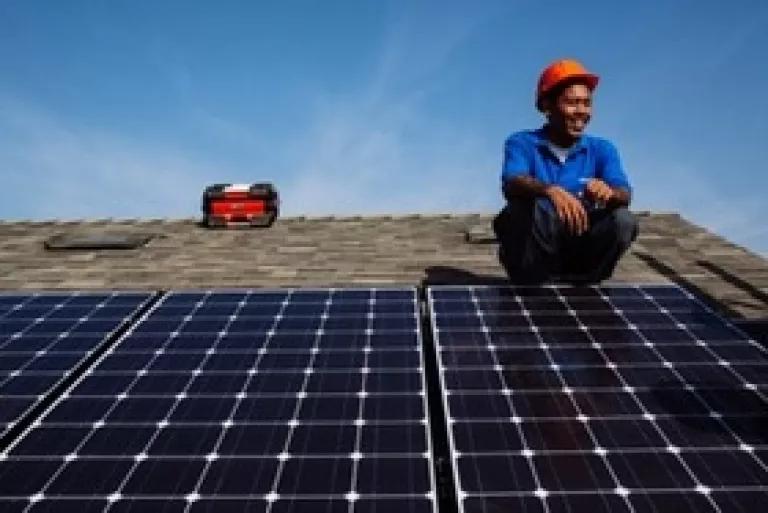
True, there were political setbacks—some at the state level and, especially, Congress’s failure to significantly extend the Production Tax Credit for wind power. (It helps level the playing field for pollution-free electricity and fight global warming by spurring wind power development that replaces fossil-fuel-generated power. But the two-week (!) extension Congress just passed that covers only 2014 and doesn’t apply the PTC to projects initiated in 2015 and beyond is just a bad joke.) Still, overall, we’ve seen serious price declines, significantly increased deployment, and state policy improvements that promise good things for the air our kids breathe, for their futures, for our ability to fight climate change, and for our economy.
To begin with, historic low prices for solar and wind power are markedly speeding deployment in many places across America. Needless to say, these are the lowest average solar and wind power prices the country’s ever seen; El Paso Electric, a Texas utility, this June signed a 20-year power purchase agreement for solar at the bargain basement price of 5.79 cents per kilowatt hour—essentially the same price as coal. Over the first three quarters of 2014, in fact, the average weighted price for solar power dropped by a full 11 percent, according to the Solar Energy Industries Association. Dizzying price declines, sparked in large part by government incentives that have spurred demand, sped economies of scale, and driven investments in technology and competition in the marketplace, have lowered the installed cost of solar by more than 53 percent since 2010.

The result: across the first three quarters of 2014, almost 4,000 megawatts of solar power came online, enough to power more than 650,000 homes. (If you really want to understand the hammering pace of solar’s growth, note that the total number of grid-tied systems installed in 1998 was a mere 34. That’s right: 34.) Now, across the country, 36 percent of all new electric generating capacity installed from January 1 through the end of September came from solar. Not only that, but the total amount of solar installed in the first three-quarters of 2014 was 41 percent higher than in the same time period last year. That’s pretty impressive. And, analysts predict much more to come.
For wind, the figures are similarly mesmerizing: Prices have dropped by 15 percent in the last year alone and 58 percent over the last five years, according to a study by the financial advisory firm Lazard. Wind power now supplies more than 4.5 percent of the nation’s electricity, up from only 0.3 percent 10 years ago. In several locations around the country, wind power is now the cheapest form of electricity, bar none. And in some states, like Iowa and South Dakota, wind provides more than 25 percent of all electricity. (Another seven states get at least 12 percent of their electricity from wind power: Kansas, Idaho, Minnesota, North Dakota, Oklahoma, Colorado, and Oregon.) Meanwhile, wind and solar power are being ably and reliably integrated into the nation’s grid in increasing amounts, as NRDC’s new fact sheet illustrates.
On the state level, we’ve seen important efforts to make solar power more accessible to the many, many people who want it. As I wrote earlier this week, New York is moving to allow community solar, which makes it easier for tenants, low-income customers and others partake in solar. Furthermore, New York’s NY-Sun Initiative grew significantly this year, too, and will now promote 3,000 megawatts of solar throughout the state by 2023. The Initiative includes a first-of-its-kind program called K-Solar (read that “K through Solar”) to help K-12 schools across the state tap into the energy savings and educational benefits that come with installing solar at schools.
Meanwhile, worldwide clean energy investment reached $175.1 billion, after two years of declines. The folks at BNEF recently told me that US clean energy investment in the first 3 quarters totaled $26.8 billion. Wind and solar makes up the vast majority of this coming in at $21.4 billion and the small scale solar (<1MW) being the largest single subsector at $8.6 billion.
Attacks on renewable energy standards
Some not-so-good news this year came in the form of attacks on renewable energy standards at the state level. In states such as Kansas and Ohio, legislators affiliated with fossil-fuel-funded groups like American Legislative Exchange Council have pushed hard to overturn and weaken the standards that require utilities to purchase a specific percentage of their electricity from pollution-free sources like wind and solar. In Ohio, ALEC-funded pols succeeded in putting the state’s standard on hold for two years while a legislative committee stacked with anti-renewable energy legislators reviews it. In Kansas, efforts to overturn the standard there failed this spring. But Kansas’ solar policies are now less consumer-friendly and we expect more attacks on the renewable energy standard soon. Utilities and others in some states have also tried to roll back pro-solar policies by adding significant charges to solar users’ electric bills. Most, but not all, of those efforts have fallen flat.
Trying to kill the PTC
Two groups funded by fossil-fuel billionaires Charles and David Koch—Americans for Prosperity and the American Energy Alliance—pushed hard in Congress’s lame-duck session and throughout the year to make sure the expired Production Tax Credit for wind power wasn’t extended into 2015 and beyond. They succeeded. Congress’ failure does nothing to help wind developers looking to start new projects and complete those now on their drawing boards. (NRDC has spoken with several developers recently who’ve said they must put projects on hold indefinitely because the PTC doesn’t carry into next year.) We and our allies will push hard to have this tax provision extended in the next Congress.
A plan for clean power
But the best news about federal renewable energy policy this year came in the EPA’s announcement of its Clean Power Plan to cut carbon pollution from existing power plants, proposed in June. It will be finalized this summer, and if NRDC’s and other efforts count, strengthened, too. Because the CPP allows states and regions to use renewable energy (and energy efficiency) to reduce their carbon emissions, it’s the most important renewables policy we have right now as a nation. In fact, using the same model the EPA uses, NRDC calculated that a strengthened and cost-effective version of the plan could spur development of enough solar and wind power in 2030 to provide electricity to about 43 million homes. That’s not all we need, but it’s not a bad start.
Fossil-fuel interests are always trying to hamper renewable energy’s snowballing progress. But this year, we’ve got market force, public support and the EPA on our side. At NRDC, we’re working hard to make sure all those continue, for your kids and mine, for many years to come.
Photos: Lexey Swall

